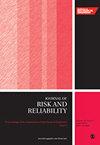A comparison between computer vision- and deep learning-based models for automated concrete crack detection
IF 1.8
4区 工程技术
Q3 ENGINEERING, INDUSTRIAL
Proceedings of the Institution of Mechanical Engineers Part O-Journal of Risk and Reliability
Pub Date : 2022-12-20
DOI:10.1177/1748006X221140966
引用次数: 0
Abstract
Systems subjected to continuous operation are exposed to different failure mechanisms such as fatigue, corrosion, and temperature-related defects, which makes inspection and monitoring their health paramount to prevent a system suffering from severe damage. However, visual inspection strongly depends on a human being’s experience, and so its accuracy is influenced by the physical and cognitive state of the inspector. Particularly, civil infrastructures need to be periodically inspected. This is costly, time-consuming, labor-intensive, hazardous, and biased. Advances in Computer Vision (CV) techniques provide the means to develop automated, accurate, non-contact, and non-destructive inspection methods. Hence, this paper compares two different approaches to detecting cracks in images automatically. The first is based on a traditional CV technique, using texture analysis and machine learning methods (TA + ML-based), and the second is based on deep learning (DL), using Convolutional Neural Networks (CNN) models. We analyze both approaches, comparing several ML models and CNN architectures in a real crack database considering six distinct dataset sizes. The results showed that for small-sized datasets, for example, up to 100 images, the DL-based approach achieved a balanced accuracy (BA) of ∼74%, while the TA + ML-based approach obtained a BA > 95%. For larger datasets, the performances of both approaches present comparable results. For images classified as having crack(s), we also evaluate three metrics to measure the severity of a crack based on a segmented version of the original image, as an additional metric to trigger the appropriate maintenance response.基于计算机视觉和深度学习的混凝土裂缝自动检测模型的比较
连续运行的系统暴露于不同的失效机制,如疲劳、腐蚀和温度相关的缺陷,这使得检查和监测系统的健康状况至关重要,以防止系统遭受严重损害。然而,目视检查在很大程度上依赖于人的经验,因此其准确性受到检查员的身体和认知状态的影响。特别是,民用基础设施需要定期检查。这是昂贵的、耗时的、劳动密集型的、危险的和有偏见的。计算机视觉(CV)技术的进步为开发自动化、精确、非接触和无损的检测方法提供了手段。因此,本文比较了两种不同的图像裂纹自动检测方法。第一个是基于传统的CV技术,使用纹理分析和机器学习方法(基于TA + ml),第二个是基于深度学习(DL),使用卷积神经网络(CNN)模型。我们分析了这两种方法,在一个真实的裂缝数据库中比较了几种ML模型和CNN架构,考虑了六种不同的数据集大小。结果表明,对于小型数据集,例如多达100张图像,基于dl的方法获得了~ 74%的平衡精度(BA),而基于TA + ml的方法获得了> 95%的BA。对于更大的数据集,两种方法的性能表现出可比较的结果。对于被分类为有裂缝的图像,我们还评估了三个指标,以基于原始图像的分割版本来衡量裂缝的严重程度,作为触发适当维护响应的附加指标。
本文章由计算机程序翻译,如有差异,请以英文原文为准。
求助全文
约1分钟内获得全文
求助全文
来源期刊

Proceedings of the Institution of Mechanical Engineers Part O-Journal of Risk and Reliability
ENGINEERING, MULTIDISCIPLINARY-ENGINEERING, INDUSTRIAL
CiteScore
4.50
自引率
19.00%
发文量
81
审稿时长
6-12 weeks
期刊介绍:
The Journal of Risk and Reliability is for researchers and practitioners who are involved in the field of risk analysis and reliability engineering. The remit of the Journal covers concepts, theories, principles, approaches, methods and models for the proper understanding, assessment, characterisation and management of the risk and reliability of engineering systems. The journal welcomes papers which are based on mathematical and probabilistic analysis, simulation and/or optimisation, as well as works highlighting conceptual and managerial issues. Papers that provide perspectives on current practices and methods, and how to improve these, are also welcome
 求助内容:
求助内容: 应助结果提醒方式:
应助结果提醒方式:


